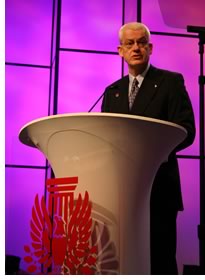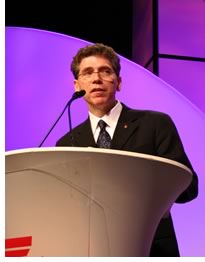

05/2005
The highlight of May 20 at the AIA 2005 AIA Convention plenary session was a panel discussion on the critical need for architects to acquire the technology and training to make them part of the interoperable world of 3D computerized design, modeling, fabrication, construction, and operation of buildings. The morning’s session started off, as well, with recognition of three researcher partners and the 2005 Topaz Medallion recipient.
 A rousing collage of college fight songs and insignias greeted attendees
of the AIA national convention in Las Vegas as they joined the general
session Friday morning. The chorus culminated in “Hold that Tiger,” the
theme of the Tigers of Louisiana State University, the alma mater of
the first speaker, AIA Executive Vice President/CEO Norman L. Koonce,
FAIA.
A rousing collage of college fight songs and insignias greeted attendees
of the AIA national convention in Las Vegas as they joined the general
session Friday morning. The chorus culminated in “Hold that Tiger,” the
theme of the Tigers of Louisiana State University, the alma mater of
the first speaker, AIA Executive Vice President/CEO Norman L. Koonce,
FAIA.
“This morning’s text is knowledge and education,” Koonce said. “As you entered this room this morning, we wanted you to participate in an AIA salute to America’s schools of architecture. It is in our nation’s schools with their dedicated faculty and inspired administrators that a great body of knowledge essential to our profession’s success is passed along to the next generation of architects.”
Koonce asked the audience to join him in recognizing the architecture education community present. “Thank you who are students and the future of our profession, and you who teach and administer for your dedication to the great and noble art of opening young minds to visions and dreams,” he said.
 Chong, Kaiser Foundation, UC Berkeley earn Latrobe Fellowship
Chong, Kaiser Foundation, UC Berkeley earn Latrobe Fellowship
Kicking off the tribute to education, in particular advancing the profession’s
knowledge, Koonce introduced College of Fellows Chancellor Lawrence J.
Leis, FAIA, to award the Latrobe Fellowship, which provides $100,000
biennially for research into the profession of architecture. Leis—with
Vice Chancellor Ted P. Pappas, FAIA; Bursar Carole J. Olshavsky, FAIA;
and Secretary Frank E. Lucas, FAIA— awarded the 2005 fellowship
to Gordon Chong, FAIA; the Kaiser Foundation Health Plan (represented
by Barbara Denton); and the University of California-Berkeley (represented
by Mike Martin, FAIA).
“Their proposal, in many ways, has been inspired by the sensory research of the 2003 Latrobe Fellow John Eberhard, FAIA, and the Academy of Neuroscience for Architecture,” Leis explained. “The group plans to develop clinical trials with willing users that test the perception of space, form, color, and light. They will document tangible evidence of the positive or negative effects that design stimuli can have on specific users in the health-care environment.”
LA in 2006!
AIA Vice President-elect Kate Schwennsen, FAIA; National Chair Michael
Broshar, AIA; and Local Chair David Martin, FAIA, tantalized the audience
with a glimpse of plans for next year’s convention, June 8–10
in Los Angeles, where architects and related professionals will gather
to investigate “Innovation, Engagement, and Inspiration.” A
short video highlighted the many draws to the City of Angels, including
its superlative architecture and convenient, far-reaching mass transit.
 Allen receives Topaz Medallion
Allen receives Topaz Medallion
AIA President Douglas L Steidl, FAIA, quoted American historian Henry
Adams, who said, “A teacher affects eternity; he can never tell
where his influence stops.”
“It’s for this reason that among the three most prestigious honors conferred by the AIA, the Topaz Medallion has unique standing, Steidl said. “The Topaz Medallion is not about building projects, it’s about building minds and nurturing souls.” Association of Collegiate Schools of America President Rafael Longoria joined Steidl to present the 2005 Topaz Medallion to Edward Allen, FAIA, the Pietro Belluschi Distinguished Professor of Architectural Design at the University of Oregon.
“I'm deeply grateful for this award,” Allen said, as he thanked the AIA and ACSA for making it available. He also expressed gratitude to his nominators, Christine Theodoropoulos, AIA; John Ochsensdorf; Richard Fitzgerald; and Jane Weinzapfel, FAIA.
“I believe that I am only the second person to receive this award who is identified primarily with the teaching of building technology, Allen noted. “The first was the great Mario Salvadori.” Technical education in architecture has come a long way, Allen said, but it still has a long way to go to make it fully relevant to the practice of architecture and the production of good buildings. He believes that at too many schools of architecture, there is still “a great, un-crossable gulf between the design studios and the technical courses.”
 “Architecture, in both its visual and its technical aspects, is
all one thing, and that thing is design,” Allen concluded. “Accordingly,
we must learn to teach technology as
design.”
“Architecture, in both its visual and its technical aspects, is
all one thing, and that thing is design,” Allen concluded. “Accordingly,
we must learn to teach technology as
design.”
Make the change or get lost in it
“Yesterday, we looked at the power of architecture from the perspective
of community values,” Steidl said. “Now, it’s time to
switch on the other side of our brains, the side that focuses on technology
and the tools that are shaping the future of building design and construction.
Increasingly we are aware that the application of advanced digital information
and imaging techniques is changing practice, especially how we communicate
with clients and our partners in the building trades.” Steidl then
presented McGraw-Hill Construction President Norbert W. Young Jr., FAIA,
to introduce the session.
 The McGraw-Hill Construction vision is to bring people together with
the current concepts of developing databases of visual information in
ways that blend space, form, and time that can be shared seamlessly among
designers, constructors, and owners. The difference between that way
of thinking, which is practical, given the tools that are already being
developed, Young said, is very different from the way the process currently
works. The Building Information Model, a locus for the panel discussion,
allows space, form, and time to be represented in a single interoperable
model, Young said. He introduced panel moderator Daniel Friedman, PhD,
FAIA, director of the University of Illinois at Chicago School of Architecture.
The McGraw-Hill Construction vision is to bring people together with
the current concepts of developing databases of visual information in
ways that blend space, form, and time that can be shared seamlessly among
designers, constructors, and owners. The difference between that way
of thinking, which is practical, given the tools that are already being
developed, Young said, is very different from the way the process currently
works. The Building Information Model, a locus for the panel discussion,
allows space, form, and time to be represented in a single interoperable
model, Young said. He introduced panel moderator Daniel Friedman, PhD,
FAIA, director of the University of Illinois at Chicago School of Architecture.
To illustrate how thinking in four dimensions—3D over time—is not a philosophy but a state of mind, the panel brought together five innovators, all with architectural backgrounds yet each with a different perspective on the Building Information Model, Friedman explained. Tools that will help us implement the full dress rehearsal of 4D design exist, he said, and the day’s discussion will offer a glimpse into what the coming world of design and construction will look like. But, he warned, true team interaction through technology will require hard work on the architects’ part.
Copyright 2005 The American Institute of Architects.
All rights reserved. Home Page ![]()
![]()
